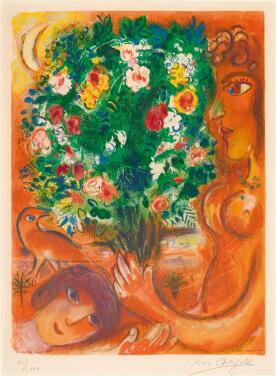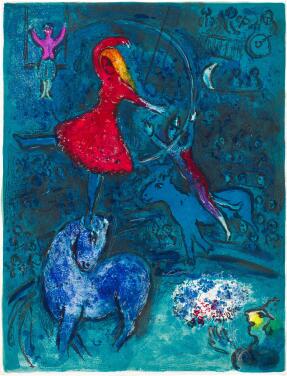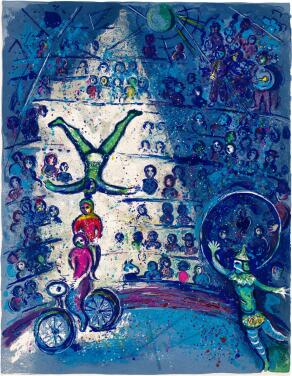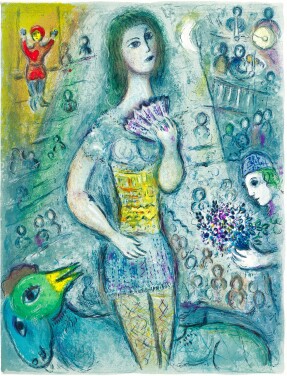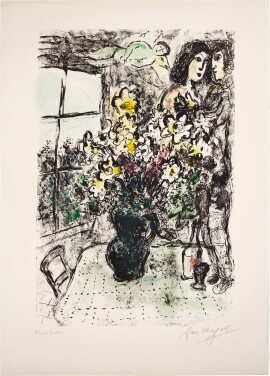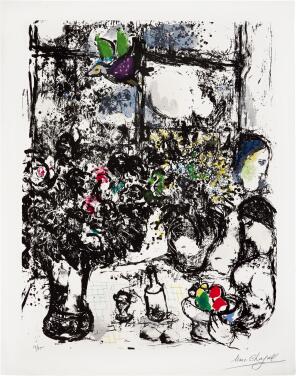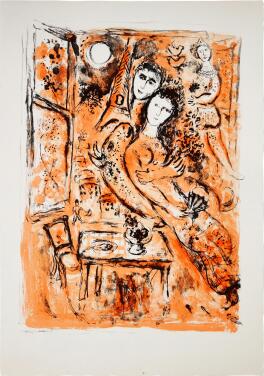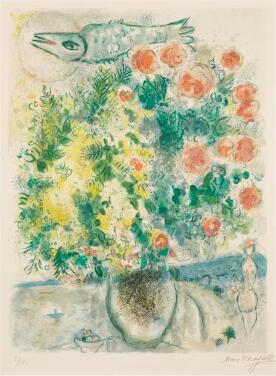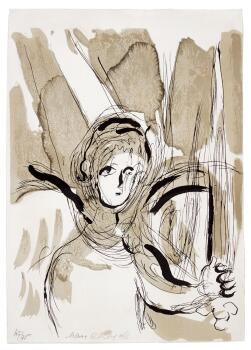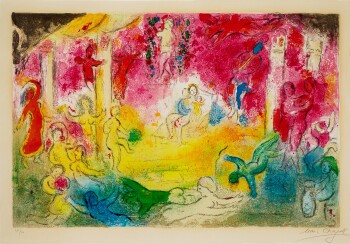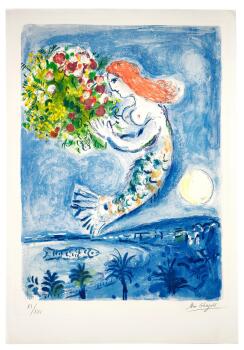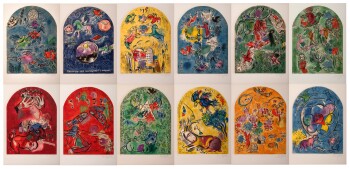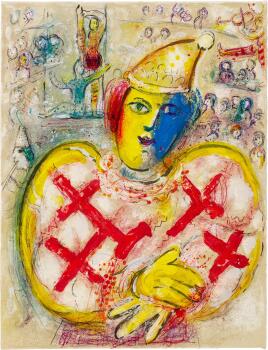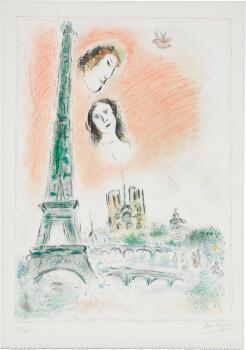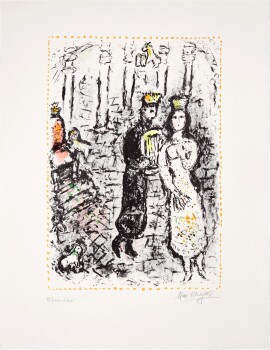Marc Chagall’s Colourful Reverie celebrates the visionary printmaker’s mastery of lithography and colour. Each of the ethereal prints presented in this sale explores Chagall’s dreams and memories: “When I held a lithographic stone or a copperplate in my hand I thought I was touching a talisman,” the artist recalled, “It seemed to me that I could put all my joys and sorrows in it.”
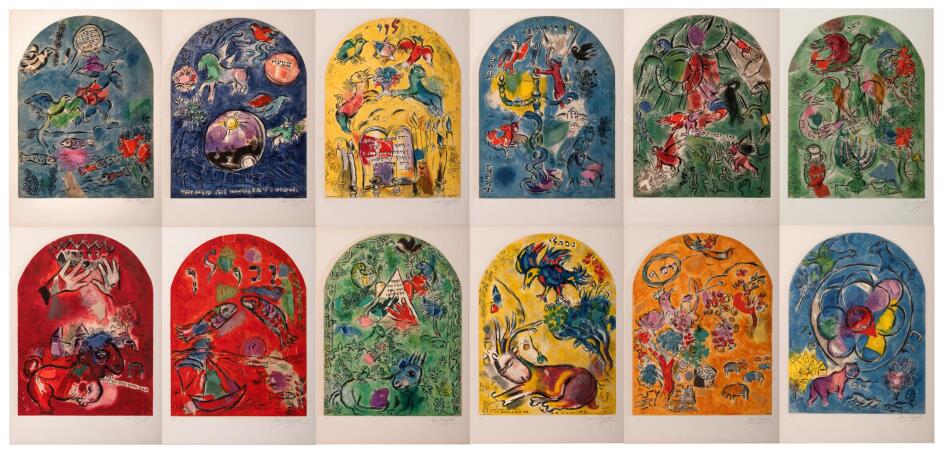
View Lot
Circus
The circus was a lifelong source of joy and inspiration for Marc Chagall. As a child in Vitebsk, he was enchanted by the traveling performers who enlivened his village’s fairs. Their playful music, acrobatics and elaborate costume appeared other-worldly to the young boy in provincial Russia. “For me, a circus is a magic show that appears and disappears like a world,” he waxed poetic of his favourite spectacle, “These clowns, bareback riders and acrobats have made themselves at home in my visions. Why? Why am I so touched by their make-up and their grimaces? With them I can move towards new horizons.”
As an emerging artist in Paris, Chagall attended the storied Cirque d’Hiver alongside famed art dealer Ambroise Vollard. Vollard kept a seasonal box at the Cirque, where Chagall could be found nightly, eagerly sketching in preparation for a series of whimsical gouaches, aptly known as the Cirque Vollard. Forty years later, with the circus still on his mind, Chagall created a portfolio of 38 kaleidoscopic lithographs inspired by his gouaches: his printed masterwork known as Le Cirque. The painterly medium of lithography allowed the freedom and spontaneity necessary to create an animated world of tumbling and flying characters. The complete Cirque is represented in Marc Chagall’s Colourful Reverie, from trapeze artists to gravity-defying unicyclists.
Romance
“He is a painter who was born a Romantic,” the publisher Tériade declared of his dear friend and colleague Marc Chagall. Indeed, romance is ever-present in the Belarusian artist’s printed work, appearing plainly in the form of couples embracing, or symbolically with the depiction of fragrant bouquets. Brides and lovers in flight pervade Chagall’s vibrant lithographs, inspired by his first and second wives: Bella Rosenfeld and Valentina “Vava” Brodsky.
Chagall met the writer Bella Rosenfeld shortly before his initial Parisian sojourn. Her poetic recounting of their meeting starts, “When you did catch a glimpse of his eyes, they were as blue as if they’d fallen straight out of the sky…” The infatuation was mutual, and Bella became his eternal muse. She is often depicted floating angelically alongside the artist himself, as if the two are perpetually sweeping each other off their feet.
Even after her untimely death in 1944, Bella’s likeness populated Chagall’s printed body of work. She is believed to be the inspiration for the equestriennes of Le Cirque, and the heroine of Nice et la Côte d’Azur, both created while Chagall was married to his second wife, Vava Brodsky. A London milliner of Russian Jewish origin, Vava became Chagall’s secretary, then his partner. She was his greatest supporter in his final decades and encouraged him to expand his reputation internationally.
Paris
Moishe Shagall first moved to Paris in 1910, settling in a cramped studio in Montparnasse. The young artist immersed himself in the city’s famous museums and the French language - even adapting his name to Marc Chagall. Over the next four years, he studied the Impressionists, befriended the Cubists, and developed his own avant-garde visual language. Of that early period, Chagall wrote, “The soil that had nourished my art was Vitebsk; but my art needed Paris as much as a tree needs water.”
Chagall returned to the arts capital in 1923 to find printmaking very much in fashion. At the behest of his literary friends and the renowned art dealer Ambroise Vollard, he delved into etching, then lithography, in order to illustrate fine books and poems. Fascinated by printmaking, the artist went on to create more than 1,000 independent editioned works. Paris, Chagall’s principle muse, is either the central focus or backdrop of many of his prints. Through his graphic oeuvre, he paid homage to the city, which he claimed, “lit up my shadowy world like the sun.”
South of France
Traveling south to Nice and the Côte d’Azur, Chagall felt he was “born for the second time”. The sunshine and sparkling waters of the French Riviera captured the artist’s imagination, so much so that he abandoned his beloved Paris for the charming town of Saint Paul de Vence. Nestled in the hinterlands, high above the sea, the Medieval village was a modest cultural hub, host to film sets and foreign actors, itinerant artists, and reclusive writers. Together with his second wife Vava, Chagall spent the last twenty years of his life in this creative community, inspired by its inhabitants and the surrounding landscapes.
After their move in 1966, the South of France replaced Paris as Chagall’s chief muse. Inspired by the mystique of the Mediterranean, Chagall completed a series of gouache paintings depicting entwined lovers floating above ramparts or coasts, often flanked by alluring mermaids, twittering birds, and lush flowers. Wishing to share the series with a broader audience, he supervised master printer Charles Sorlier in the creation of twelve dream-like lithographs after the paintings, a series known as Nice and the Côte D’Azur.



